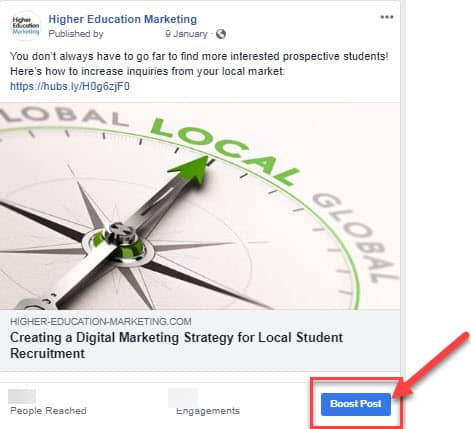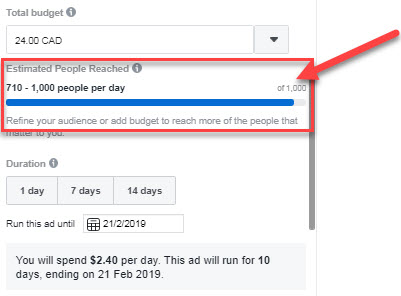
It’s an unfortunate fact of life for many social media marketers that no matter how much time and energy you spend on crafting thoughtful, interesting content, you can still find yourself disappointed with your results.
The competition for visibility on major social networks is such that even your best posts often go unseen by a large chunk of your audience. For schools, this can be a huge obstacle to growing your online community, hindering your chances of attracting new followers and connecting with existing prospects.
Paying to promote or ‘boost’ select posts can be an effective solution, ensuring your most valuable social media content gets the visibility it deserves, and even improving your organic reach in the long-term. Keep reading to learn how to get started.
Why Should Your School Promote Social Media Posts?
For the few marketers who got involved in social media in its early days, the channel was something of a playground. Businesses of all kinds could promote themselves to a wide, engaged audience at no cost other than the time it took to create a post.
As the medium became more popular, though, it also became more crowded. As more and more organizations began to use sites like Facebook and Twitter for marketing, users grew tired of seeing nothing but branded content in their feeds.
To change this (and arguably, to better monetize their business) social networks began restricting the the amount of branded content users saw. Businesses on Facebook have famously seen their organic reach dwindle rapidly over the past number of years. While statistics vary depending on time period or number of followers, many experts estimate that is has been as low as 2% for most publishers since 2016:

To put that in simple terms, it means that if your school has 1,000 followers on Facebook, only around 40 of them are actually seeing each of your posts. Organic reach on Twitter and Instagram has also dropped, largely due to their move away from chronological newsfeeds to algorithmic models in 2016. This meant that what showed up in a user’s feed was determined by what the social network thought they would find most engaging, rather than what was posted most recently.
While it might seem counterintuitive, paying to increase the reach of your posts can be the simplest, most effective way of circumventing this problem. It’s usually quite cheap, relatively easy to do, and can have very effective results.
What’s more, a successful paid post can have a knock-on effect on your organic reach in the future. When people engage with your posts, it sends a message to the social network’s algorithm that they would like to see more of them in the future. As a result, your organic efforts will be shown to more people as time goes on. An experiment carried out by Agora Pulse showed that the organic reach of 10 non-paid posts following a Facebook boosted post increased as much as 25% compared to past performance:

With that in mind, promoting your higher education social media posts could actually prove to be a very cost-effective strategy in the long-term.
Deciding Which of Your Higher Ed Social Media Posts to Promote
Unless you have a very specific reason for wanting a particular post to reach a wider audience, most experts recommend that you promote your most popular posts. Social media content that has already attracted a lot of reach has been proven to pique the interest of your school’s online community. By promoting it, you are simply amplifying its power to engage more prospects.
A good starting point is to analyze the organic reach and engagement of your posts and establish a minimum threshold a post should reach before you consider boosting it. For this reason, it’s best to allow a post to live on your page for a while and see what organic return it gets before promoting it.
Example: This post from CES Dublin about their summer Language and Sailing course has attracted a healthy amount of views and engagement, and could be well-placed to benefit from a boosting campaign.

Having said that, you shouldn’t blindly promote all of your popular posts. Some might be particularly topical or specific to a current time or event, and won’t be relevant if they appear to followers at a later date. For instance, a post wishing luck to students during exam time might perform well, but you wouldn’t promote it a few weeks after exams had finished.
Example: This Instagram post from the University of Nebraska-Lincoln has attracted a lot of engagement and has a strong call to action advertising their Charter Week, an occasion that features events for current students, alumni, future prospects, and the general public. However, it’s time-sensitiveness would give the school a limited window of opportunity to promote it.

The key is to have a specific goal in mind for your promoted posts. If you want to drive more traffic to your website or encourage prospective students to make inquiries, ensure you select posts with an effective call to action, and provide links to your website or a relevant landing page. Even if you are simply looking to elevate your reach or attract followers on the social network itself, you should carefully consider whether the posts you are choosing have the power to resonate with a wider audience. This will ensure that your promoted posts truly amplify your presence, and work in harmony with your other channels and efforts towards a common outcome.
Choosing Which Social Channels Your School Should Invest In
Obviously, you are going to want to make the most of any budget you put towards promoting your higher ed social media posts, so it’s important to carefully consider which channels are worth investing in for your school.
All of the major social networks offer some form of paid amplification for your posts. They also make it possible to do it on your page itself rather than through the site’s native ad platform. Simply click the button next to the post you want to promote – ‘Boost Post’ on Facebook, ‘Promote’ on Instagram, ‘Sponsor’ on LinkedIn, and ‘Promote this Tweet’ on Twitter – then set the budget, run time and target audience you want, and the campaign will be up and running.
Example: The Boost Post option as displayed on one of HEM’s own Facebook Posts.

This option is quick and easy, and especially useful for those without much experience managing ad campaigns. It should be noted, however, that many experts argue against taking this route on Facebook. Instead, they advocate creating an ad from your post in Facebook Ads. The reason for this is that the audience targeting options, goals, and budgetary control are a lot more limited when compared to the full ad platform, making it harder to finetune your campaign if your goals or audience are very specific.
With that in mind, it might be a good idea to look at the options available in Facebook Ads to see if they can offer you anything that boosting can’t. However, if you can see that it’s possible to create the campaign you want through the Boost option alone, then it can be a quick and easy route to success.
Example: The targeting options for a typical boosted post on Facebook.

As far as choosing which social network to promote your posts on, a lot will obviously depend on your school’s goals and student personas. A good place to start might be to identify specific platforms that you may be underperforming on, especially if your target audience tend to be active on those sites. For example, if you are running a business school but don’t have much reach on LinkedIn, sponsoring your posts might help you attract more high-quality leads, as well as professionals who have influence in the sector.
Example: With over 100,000 followers, Columbia Business School certainly aren’t underperforming on LinkedIn! The audience the school commands shows the immense potential of investing in the platform for schools in this sector.

Alternatively, it can also be wise to focus on a social network where your school enjoys particular popularity, allowing you to capitalize on the advantage you already have over your competitors. Of course, provided you have the budget, it may be best to spread your paid posting efforts across different social networks, allowing you to build a multichannel social audience.
Setting Budgets and Run Times for Your School’s Paid Posts
Generally speaking, promoted social post options should be well within the budget of most professionals managing social media in higher education, and you will get a lot of reach from a fairly small investment. The platform itself will generally suggest an amount to spend over a period of time and give you an estimate of how much visibility to expect:

This option may be fine for you if your goal is something fairly general or isn’t time-sensitive, like attracting more followers. If you are looking to accomplish something more specific, like promoting an event, you may want to try and increase your budget and adjust your run time to give you the best chance of a short-term return.
Example: A tweet from Saint Leo University encouraging followers to register for an upcoming open house event. Putting some additional budget behind a short-term Promoted Tweet campaign could be a shrewd move for a post like this.

After you have promoted posts a few times, you will begin to get an idea what kind of budget works for you. For clarity, it can be a good tip to promote a few similar posts with the same amount of money over the same run time, and then compare the results. This will help you establish a baseline for success.
Example: Geneva Business School regularly share blog posts through LinkedIn. Since these posts are fairly similar, promoting a few of them and then comparing the results could give the school a solid basis on which to judge future efforts.

In terms of targeting, you may want to simply promote your posts to your followers in order to improve engagement. If you are looking to attract users who aren’t following your school, try to keep the target audience as specific as possible to get the results you want. Use your student personas to guide you, and you won’t go far wrong.
Above all else, its crucial to track your results properly. If your goal is conversions, make sure to set up the relevant pixels on your website and landing pages so that you can see where your traffic is coming from. If you are seeking engagement or to increase your following within a social network, using the platform’s native analytics tools to track any improvements over time will help you determine how much you are getting from your paid posts. With a little time and refinement, you will find the formula that works for your school.







